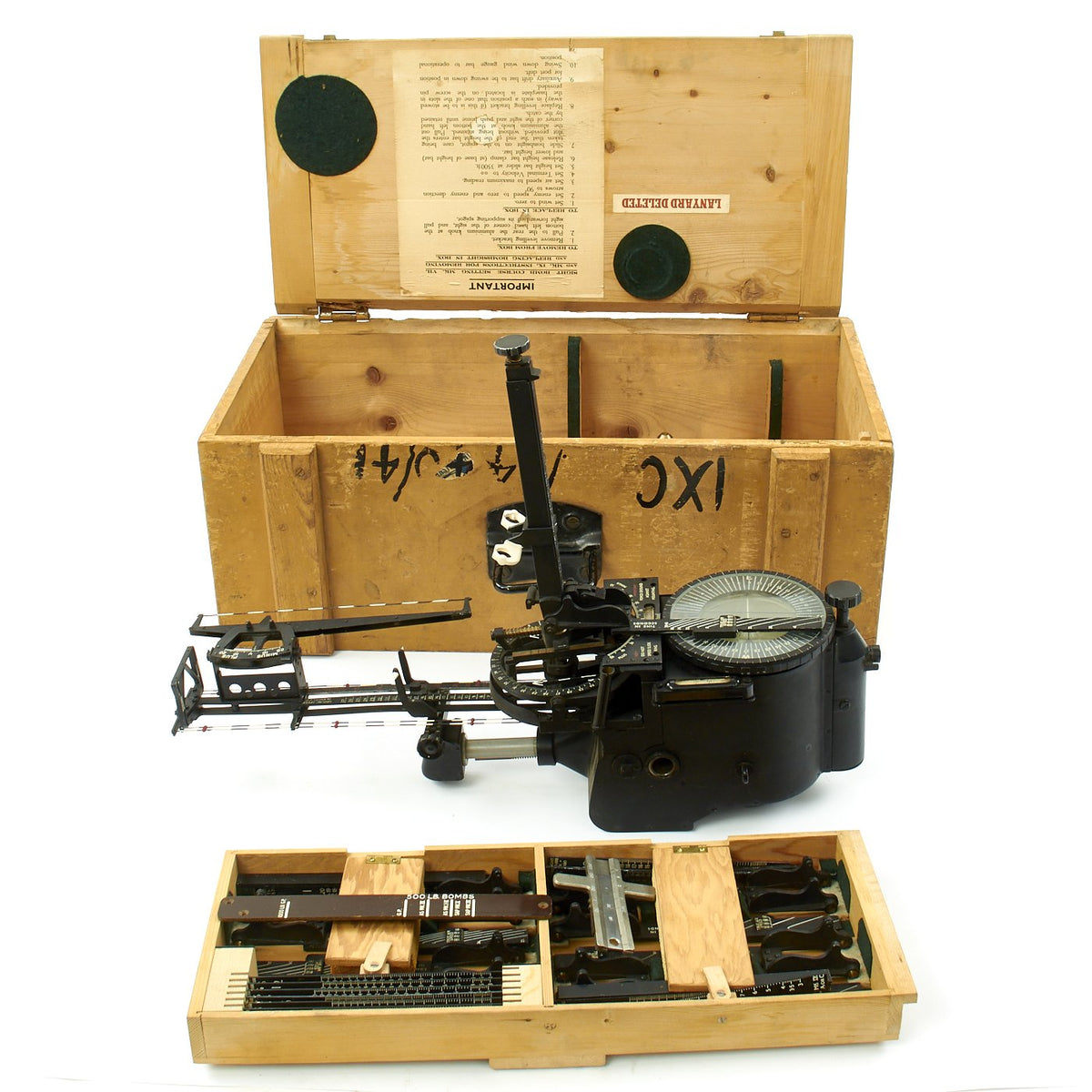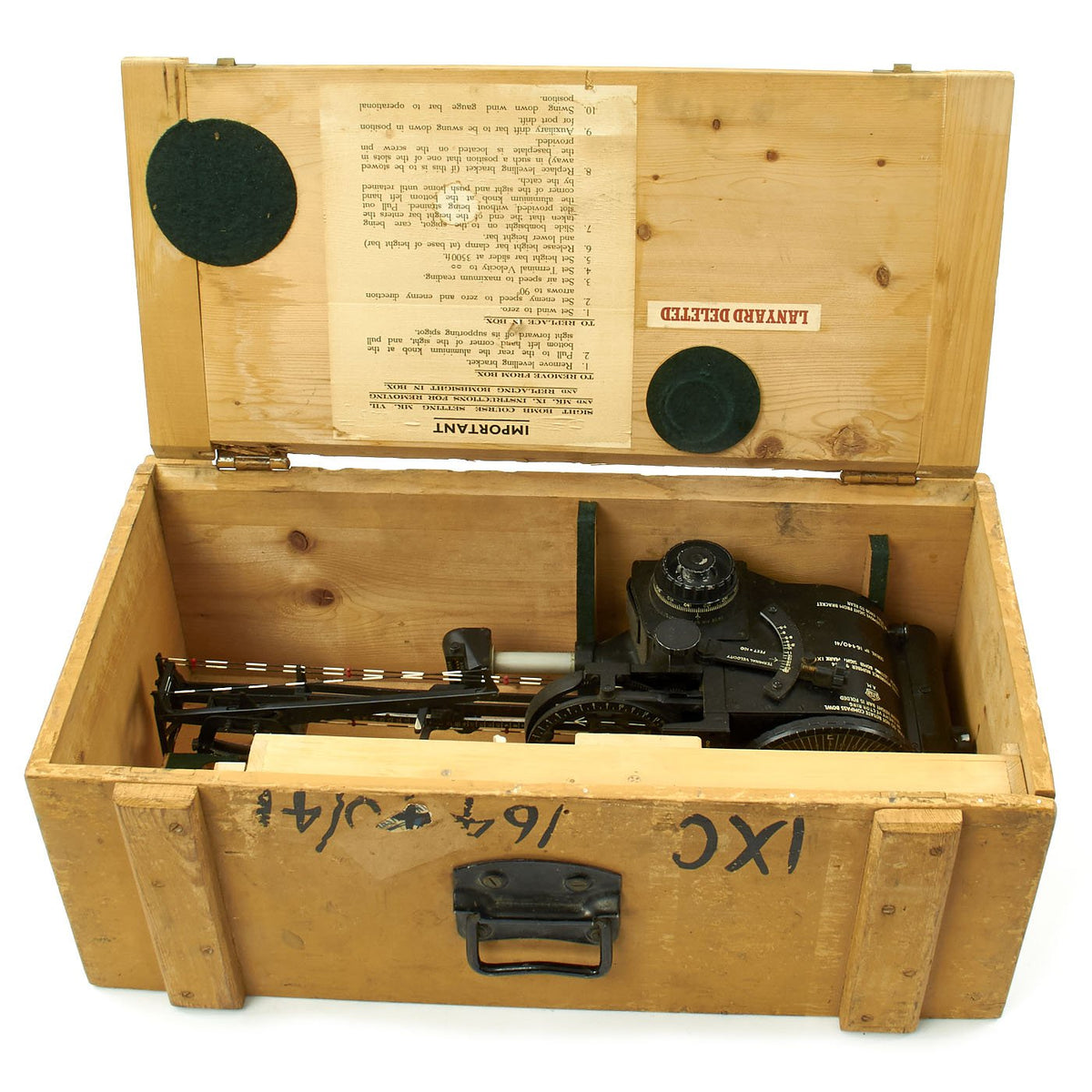Original British WWII Royal Air Force Course Setting Bomb Sight Mark IXC in Transit Chest dated 1941 Original Items
$ 695,00 $ 208,50
Original Items: Only One Available. The Course Setting Bomb Sight (CSBS) is the canonical vector bombsight, the first practical system for properly accounting for the effects of wind when dropping bombs. It is also widely referred to as the Wimperis sight after its inventor, Harry Wimperis, who started work on the sight in 1916. The idea was to put as many of the manual calculations required for aiming into an easy to use device.
The bomb aimer dialled in the wind direction on the compass, then wind speed, airspeed and altitude on different knobs. These adjustments carried out all of the adjustments needed to set the range angle properly. These also included a separate adjustment for “trail”, the deceleration of the bomb due to drag. At higher altitudes or forward speeds the bombs would reach terminal velocity long before impact, which had the effect of making the last portion of the flight path more vertical.
The CSBS was developed for the Royal Naval Air Service (RNAS) in order to attack submarines and ships. It was introduced in 1917, and was such a great advance over earlier designs that it was quickly adopted by the Royal Flying Corps, and the Independent Air Force. It has been called “the most important bomb sight of the war”.
After WWI was over, the sight continued to be used, and was gradually updated with additional adjustments and vectors to increase the usefulness and accuracy of the sight. Prior to the start of World War II even more new features were added. One modification was the “Auxiliary Drift Bar” attachment. This consisted of a single drift wire in a C-shaped clamp that could be moved along the main drift wires, and rotated in relation to them. Prior to the bomb run, the bomb aimer would sight through the backsight toward the Auxiliary Drift wire, and continually rotate the wire until objects on the ground could be seen moving directly along it – this gave the drift angle.
By 1941, the Air Ministry had approved the tenth iteration of the sight, which is what we have here.
The data plate on the top is still clear:
(Crown)
A.M.
STORES REFERENCE NUMBER 9/494
COURSE SETTING BOMB SIGHT MARK IX C
SERIAL No 16440/41
The “41” after the serial number indicates manufacture in 1941. The lid of the transit chest is marked with much of the same information, including the matching serial number. The chest itself measures 24″ x 13″ x 8 1/2″, and has a slide out tray that has numerous range scales and replacement parts for the sight, which is somewhat delicate in areas. There is also a calibration tag in the chest, indicating that the unit was overhauled on 25 / Aug / 44, so this set was definitely in use throughout the war.
Condition is very good, though we do not know if it is functional. The top knob for the TRUE AIR SPEED KNOTS has unfortunately sheared off the central pin, and is now loose around it. Other small parts may also be missing and/or broken off. It’s really a quite complex piece of machinery. The additional range scales and components in the tray are all in good condition, but we do not know if the set is complete.
A great piece of British WWII R.A.F. history, complete with the matching transit chest. Ready to display!
Fast Shipping with Professional Packaging
Thanks to our longstanding association with UPS FedEx DHL, and other major international carriers, we are able to provide a range of shipping options. Our warehouse staff is expertly trained and will wrap your products according to our exact and precise specifications. Prior to shipping, your goods will be thoroughly examined and securely secured. We ship to thousands clients each day across multiple countries. This shows how we're dedicated to be the largest retailer on the internet. Warehouses and distribution centres can be located throughout Europe as well as the USA.
Note: Orders with more than one item will be assigned a processing date depending on the item.
Before shipping before shipping, we'll conduct a thorough inspection of the items you have ordered. Today, the majority of orders will be delivered within 48 hours. The delivery time will be between 3-7 days.
Returns
The stock is dynamic and we cannot completely manage it because multiple stakeholders are involved, including our factory and warehouse. So the actual stock may alter at any time. It's possible that you may not receive your order once the order has been made.
Our policy is valid for a period of 30 days. If you don't receive the product within 30 days, we are not able to issue a refund or an exchange.
You can only return an item if it is unused and in the same state as the day you received it. You must have the item in its original packaging.
Related products
Uncategorized
Uncategorized
Uncategorized
Uncategorized
Uncategorized
Uncategorized
Uncategorized
Uncategorized
Uncategorized
Uncategorized
Uncategorized
Uncategorized
Uncategorized
Uncategorized
Uncategorized
Uncategorized
Angolan Rebel 1970s era 60mm Inert Display Mortar from Angolan Civil War Original Items
Uncategorized
Armored Burgonet Helmet & Polearm from Scottish Castle Leith Hall Circa 1700 Original Items
Uncategorized
Uncategorized
Band of Brothers ORIGINAL GERMAN WWII Le. F.H. 18 10.5cm ARTILLERY PIECE Original Items
Uncategorized
Uncategorized
Uncategorized













































































